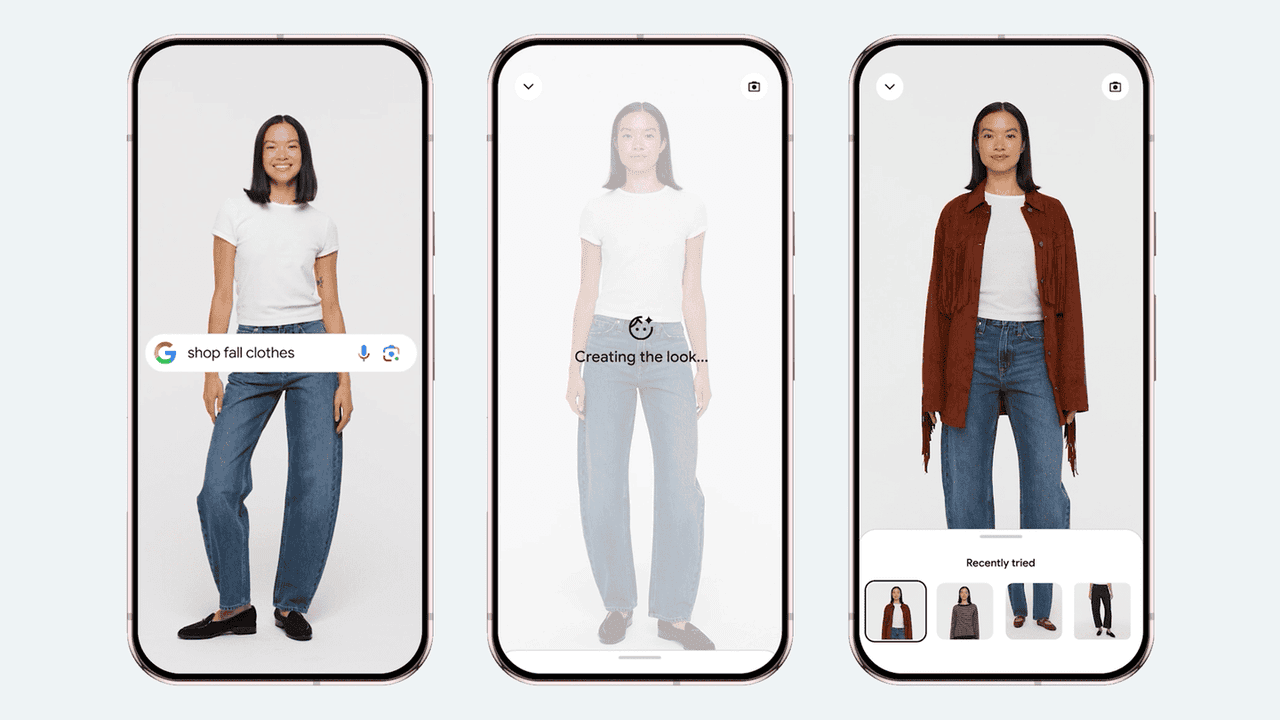Google Expands AI-Powered Virtual Try-On to Include Dresses
2 Sources
2 Sources
[1]
Google Adds Dresses to AI-Powered Virtual Try-On Offering | PYMNTS.com
Google's virtual try-on tool now lets shoppers see how they'd look in dresses. The tech giant on Thursday (Sept. 5) announced it is expanding the artificial intelligence (AI)-powered offering to cover dresses, one of its most-searched apparel categories. "This feature is made possible thanks to a generative AI technology we created specifically for virtual try-on (VTO), which uses a technique based on diffusion," the company wrote on its blog. "Diffusion lets us generate every pixel from scratch to produce high-quality, realistic images of tops and blouses on models." However, testing the diffusion technique for dresses uncovered a pair of challenges. For one, dresses in many cases feature highly detailed designs. Google compared it to trying to paint an image on a small canvas. "You can think of our VTO challenge in the same way: Our existing VTO AI model successfully diffused using low-resolution images, but in our testing with dresses, this approach often resulted in the loss of a dress's critical details -- and simply switching to high-resolution didn't help," the company said. To address this, Google researchers employed a "progressive training strategy" for VTO, where diffusion starts with lower-resolution images and gradually trains in higher resolutions to reflect finer details. In addition, because dresses cover more of a person's body than tops, Google found that "erasing" and "replacing" the dress on a person would "smudge" their features or obscure important details of their body. Google remedied this problem with a new technique called the VTO-UNet Diffusion Transformer, "which isolates and preserves a person's important features." The news comes as other major players in the eCommerce world are stepping up their virtual try-on programs. For example, Walmart in July released its first annual "Adaptive Retail Report," featuring results from a survey that looked at consumer interest in technologies such as virtual try-ons and other tools to see how items would appear in the real world. "This focus on virtual try-on and visualization technologies suggests that Walmart may be looking to step up its existing presence in the space, with its beauty, apparel and accessories digital trial offerings," PYMNTS wrote at the time. And as covered here earlier in the year, virtual try-on can help shoppers make sure they get their clothing purchases right the first time, thus eliminating a headache for retailers.
[2]
Google's virtual try-on tool adds new outfits for your fit check
Google says that it had to overcome multiple challenges to add support for dresses. It couldn't simply use the same diffusion-based AI model it used for tops, as dresses "are often more detailed than a simple top in their draping, silhouette, length, or shape -- and include everything from midi-length halters to mini shifts to maxi drop waists -- plus everything in between." Researchers at Google developed a progressive training strategy to accurately recreate fine details, like pleats and prints, in the previews. They also came up with a new technique called VTO-UNet Diffusion Transformer (VTO-UDiT), which "isolates and preserves a person's important features" in the generated image. You can check out the resulting images for yourself by searching for dresses from brands like Simkhai, Boden, Staud, Sandro, and Maje on Google.
Share
Share
Copy Link
Google enhances its virtual try-on feature in Search, now including dresses alongside tops. The AI-powered tool aims to improve online shopping experiences by allowing users to visualize clothing on diverse body types.

Google's Virtual Try-On Feature Expands to Dresses
Google has announced a significant expansion of its AI-powered virtual try-on feature in Search, now including dresses in addition to tops. This enhancement aims to revolutionize the online shopping experience by allowing users to visualize how clothing items might look on various body types
1
.How It Works
The virtual try-on tool utilizes generative AI technology to create realistic visualizations of clothing items on a diverse range of models. Users can now see how dresses appear on models with different body types, skin tones, and heights, ranging from XXS to 4XL
2
. This feature is designed to help shoppers make more informed decisions about their purchases by providing a better sense of how the garments might look on them.Availability and Accessibility
Currently, the dress try-on feature is available for shoppers in the United States when using Google Search on mobile devices. The tool supports a wide array of dress styles, including slip dresses, pencil dresses, and sundresses from various brands such as Anthropologie, Everlane, and H&M
1
.Impact on Online Shopping
This expansion of Google's virtual try-on feature addresses a common challenge in online clothing shopping: the inability to physically try on items before purchase. By providing a more comprehensive and inclusive visualization tool, Google aims to reduce the likelihood of returns and increase customer satisfaction
2
.Future Developments
Google has indicated that it plans to further expand the virtual try-on feature to include more types of clothing in the future. This ongoing development suggests a growing trend in the use of AI and augmented reality technologies in e-commerce, potentially reshaping how consumers shop for clothing online
1
.Related Stories
Privacy and Data Considerations
As with any AI-powered tool that processes user data, questions about privacy and data usage arise. Google has not provided specific details about how user data is handled in relation to this feature, but it's an important aspect for consumers and regulators to consider as these technologies become more prevalent in online shopping
2
.Industry Implications
The expansion of Google's virtual try-on feature could have significant implications for the fashion retail industry. As more consumers become accustomed to these AI-powered tools, there may be increased pressure on retailers and brands to provide similar technologies on their own platforms to remain competitive in the e-commerce space
1
.References
Summarized by
Navi
[2]










